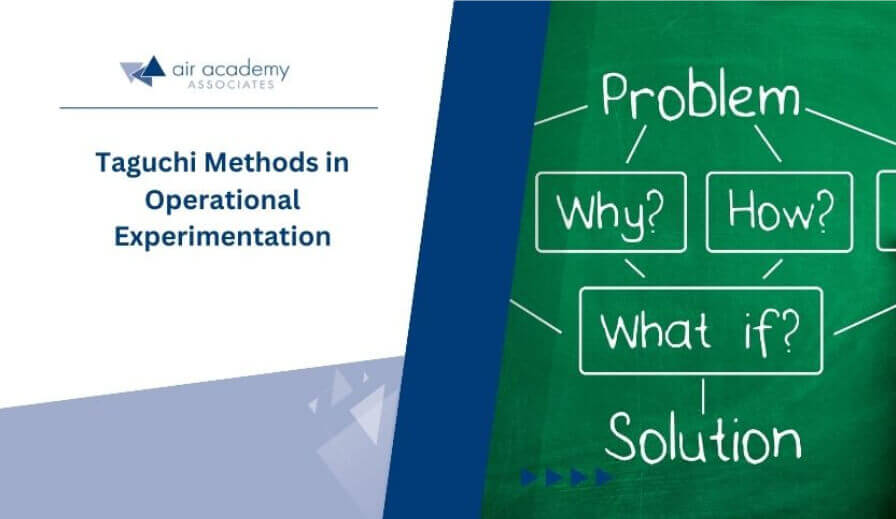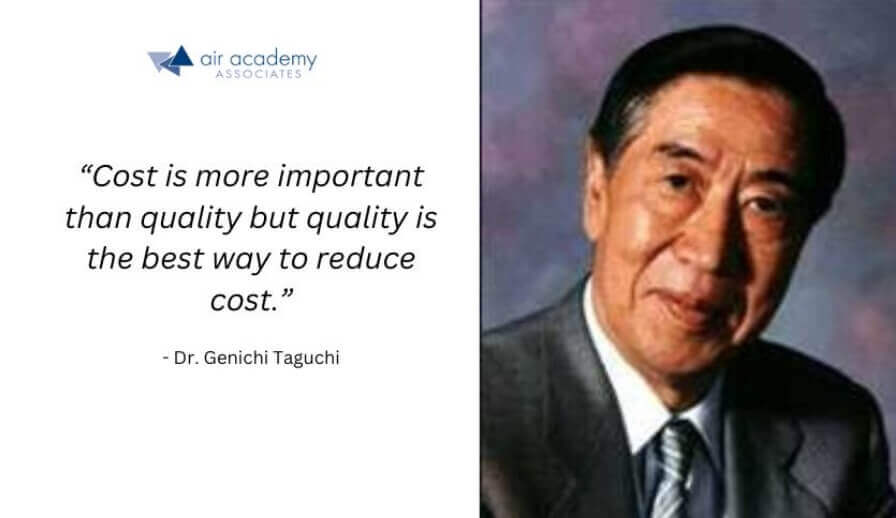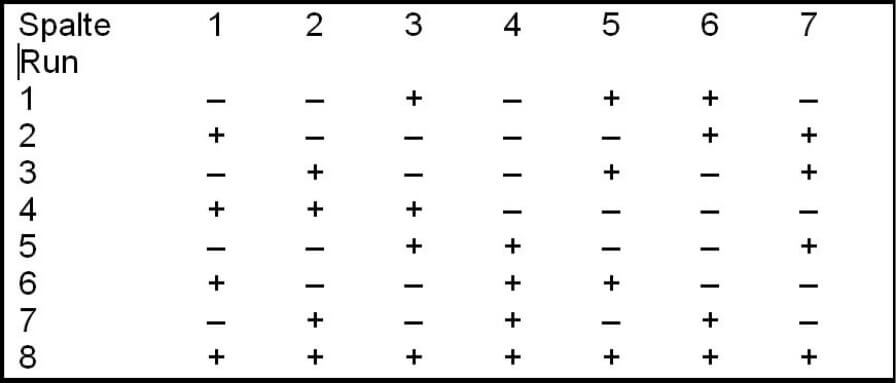
The Taguchi Method is a statistical approach within the Design of Experiments (DOE) framework that aims to improve product quality and process performance through robust design and the minimization of variation. Distinguished from traditional DOE by its focus on optimizing operational parameters to make outcomes less sensitive to external noise factors, the Taguchi Method offers a structured, efficient way to conduct experiments.
This approach benefits engineers, quality professionals, and operational managers seeking to enhance operational efficiency and product consistency with fewer resources.
This blog will provide a comprehensive overview of the Taguchi Method, emphasizing its application in operational contexts. It will also offer insights into how it can achieve operational excellence with practical examples and a step-by-step guide.
Key Takeaways
- The Taguchi Method streamlines the Design of Experiments (DOE) by focusing on robustness and efficiency, enabling significant quality and performance improvements with fewer resources.
- Orthogonal arrays, a cornerstone of the Taguchi Method, allow for the efficient exploration of multiple factors and interactions, reducing the number of experiments needed.
- Signal-to-noise (S/N) ratios simplify the analysis of experimental results, making the Taguchi Method accessible to practitioners with varying levels of statistical expertise.
- Implementing the Taguchi Method fosters a culture of continuous improvement and data-driven decision-making, essential for operational excellence and competitive advantage.
Fundamentals of the Taguchi Method

The Taguchi Method, a revolutionary approach within the realm of Design of Experiments (DOE), is predicated on the philosophy of quality engineering. Developed by Dr. Genichi Taguchi, this method emphasizes the importance of design for robustness against variations rather than merely controlling product or process variations after they occur.
Using a systematic, statistical approach, the method has gained acclaim for significantly improving quality and efficiency in manufacturing and non-manufacturing processes.
Taguchi Philosophy
The cornerstone of the Taguchi philosophy is the minimization of variation and the maximization of product and process robustness. Taguchi posits that the key to enhancing quality is designing products and processes that are inherently less sensitive to external noise factors, including environmental conditions, user variability, and material inconsistencies. This approach shifts the focus from detecting faults in the final product to preventing defects through design, thereby reducing costs and improving reliability.
Key Concepts
- Quality Characteristic: The specific attribute or property being measured and optimized in an experiment, such as strength, durability, or response time.
- Signal-to-Noise (S/N) Ratios: A statistical measure Taguchi uses to quantify the robustness of a process or product design. The S/N ratio compares the level of a desired signal to the level of background noise, with higher ratios indicating better performance under varying conditions.
- Control Factors and Noise Factors: Control factors are the operational parameters that experimenters can adjust, while noise factors are environmental, material, or process variables that are difficult or impossible to control during the experiment.
- Interaction Effects: The phenomenon where the effect of one factor on the quality characteristic depends on the level of another factor. Taguchi’s design helps identify significant interactions that impact performance.
Orthogonal Arrays
A pivotal element of the Taguchi Method is using orthogonal arrays, special matrices designed to conduct experiments efficiently and systematically. These arrays allow for the simultaneous investigation of multiple factors with fewer experiments, saving time and resources while providing comprehensive data.

By structuring experiments in this way, it is possible to assess the effects of control factors, noise factors, and their interactions on the quality characteristic without exhaustive testing of all possible combinations.
Benefits of the Taguchi Method
The Taguchi Method’s innovative approach to the Design of Experiments (DOE) offers advantages that streamline operational experimentation. These benefits facilitate a more efficient and effective experimental process and empower organizations to improve product quality and process performance. Below, we delve into a more detailed exploration of each benefit, highlighting the impact of the Taguchi Method on operational excellence.
1. Efficiency: Maximizing Resource Utilization
One of the most significant advantages of the Taguchi Method is its efficiency. Traditional factorial designs, which test all possible combinations of factors and levels, can become resource-intensive and time-consuming as the number of variables increases. In contrast, the
Taguchi Method employs orthogonal arrays to structure experiments, allowing for the simultaneous examination of multiple factors with a markedly reduced number of experimental runs. This strategic reduction in experiments directly translates to significant savings in time and resources without compromising the depth and breadth of the insights gained. Organizations can thus explore various conditions and interactions more quickly and cost-effectively, accelerating innovation and decision-making.
2. Robustness: Enhancing Product and Process Reliability
At the heart of the Taguchi Method is the principle of robustness—designing products and processes inherently resistant to environmental, material, and operational variations. By focusing on noise tolerance, the method ensures that the outcomes remain consistent and reliable under a wide range of “noise factors,” such as temperature fluctuations, varying user handling, or differences in raw materials.
This proactive approach to design minimizes the incidence of defects, failures, and performance variability, leading to higher customer satisfaction and reduced costs associated with rework and warranty claims. The robustness achieved through the Taguchi Method is a cornerstone of quality engineering, fostering resilience and dependability in products and processes.
3. Optimization: Identifying Optimal Control Factor Settings
The Taguchi Method excels in optimizing operational parameters to enhance quality and performance. Through its structured experimental design and the analysis of signal-to-noise (S/N) ratios, the method systematically identifies the settings of control factors that yield the best performance metrics.
This optimization process is crucial for achieving superior product characteristics and process efficiencies, allowing organizations to fine-tune their operations based on quantifiable data. By pinpointing the optimal conditions for quality and performance, the Taguchi Method enables companies to deliver higher-value offerings to their customers, setting a foundation for competitive advantage and market leadership.
4. Ease of Analysis: Simplifying Complex Data Interpretation
Another hallmark of the Taguchi Method is its simplification of experimental analysis. Using signal-to-noise (S/N) ratios to evaluate the quality of different experimental conditions demystifies interpreting complex data. This ease of analysis makes the Taguchi Method accessible to practitioners across various levels of statistical expertise, bridging the gap between complex statistical theory and practical application.
As a result, teams can quickly derive actionable insights from their experiments, facilitating a more agile and informed decision-making process. This accessibility also encourages a broader adoption of DOE principles across different organizational functions, promoting a culture of continuous improvement and data-driven optimization.
The Taguchi Method’s approach to DOE offers a compelling blend of efficiency, robustness, optimization, and ease of analysis. By leveraging these benefits, organizations can enhance their product quality and process performance and foster a culture of innovation and operational excellence.
The method’s focus on design for robustness and its streamlined experimental process provides a robust framework for tackling the complexities of modern operational challenges, making it an invaluable tool for quality and process improvement initiatives.
Operational Contexts and the Taguchi Method

Image Source: Freepik
The Taguchi Method’s versatile approach to the Design of Experiments (DOE) is applicable across a broad spectrum of operational contexts, from manufacturing to service delivery and beyond. This adaptability stems from its core emphasis on robustness and efficiency, universally valuable principles in any operational setting. Here, we explore various operational experiments where the Taguchi Method can have a significant impact.
Manufacturing Processes
In manufacturing, the Taguchi Method is instrumental in optimizing process parameters to enhance product quality and reduce waste. Manufacturers can achieve consistent product quality while minimizing variability and defects by identifying the optimal combination of machine settings, material properties, and environmental conditions. This approach is particularly beneficial in injection molding, metal stamping, and chemical manufacturing, where precision and reliability are paramount.
Service Delivery Improvements
Service industries can also benefit from the Taguchi Method by optimizing operational processes to improve service quality and customer satisfaction. For instance, the method can reduce patient wait times and improve treatment outcomes in healthcare. It can help refine service delivery models to enhance guest experiences in the hospitality sector, demonstrating the method’s applicability beyond traditional manufacturing environments.
Software Development
The Taguchi Method applies to software development by optimizing various aspects of the development process, including coding efficiency, bug resolution times, and feature deployment speeds. Software teams can use the Taguchi approach to minimize errors and improve overall software quality and user satisfaction by treating code revisions, testing protocols, and deployment strategies as control factors.
Implementing the Taguchi Method in Operational Experiments

Image Source: Freepik
Implementing the Taguchi Method requires a structured approach, from the planning phase to analysis and optimization. The following step-by-step guide ensures a comprehensive understanding and practical application of the method in operational experiments.
Step 1: Objective Definition
The first step involves clearly defining the experiment’s goal. This could range from improving product durability and service delivery speed to increasing software application stability—a well-defined objective guide selecting quality characteristics to be measured and optimized.
Step 2: Selection of Control Factors, Levels, and Noise Factors
Identify the control factors that can be manipulated and the noise factors that represent sources of variability but cannot be controlled. For each control factor, decide on the levels (different values or settings) to be tested. This phase is crucial for understanding which aspects of the operation will be varied and how external variations might impact the outcomes.
Step 3: Choosing the Appropriate Orthogonal Array
Select an orthogonal array that matches the number of control factors and levels to be tested, ensuring an efficient yet comprehensive exploration of the experimental space. The array choice depends on the experiment’s complexity and the interactions expected among factors.
Step 4: Conducting the Experiments and Collecting Data
Execute the experiments as laid out in the chosen orthogonal array, carefully recording the results for each trial. This step may involve running manufacturing processes under different settings, delivering services with varied approaches, or deploying software features through distinct development pathways.
Step 5: Analyzing Results Using Signal-to-Noise Ratios and Other Statistical Methods
Analyze the collected data using signal-to-noise (S/N) ratios to determine which factor levels lead to the best performance, considering both the mean of the quality characteristic and its variability. This analysis helps identify the optimal settings that make the product or process most robust to noise factors.
Tips for Effective Implementation

Image Source: Freepik
Factor Selection: Prioritizing Impactful Variables
The selection of factors to include in your Taguchi Method experiments is a critical step that requires careful consideration. Not all factors have the same level of impact on the quality characteristics of interest. To ensure the efficiency and relevance of your experiments, it’s essential to:
- Identify Key Factors: List all potential factors that could influence the outcome of your process or product quality. This includes control factors (those you can change) and noise factors (those you cannot control but can simulate).
- Prioritize Based on Impact: Use historical data, expert judgment, or preliminary studies to prioritize these factors based on their expected impact on the quality characteristic. Focus on including those factors that are likely to have a significant effect, as this will enhance the sensitivity of your experiment to meaningful variations.
- Consider Interactions: Acknowledge that some factors may interact, meaning the effect of one factor could depend on the level of another. Including factors that are suspected or known to interact can provide valuable insights into complex process dynamics.
Experiment Repetition: Verifying and Validating Results
The repetition of experiments is a fundamental principle in scientific research and engineering that holds particular value in the context of the Taguchi Method. Repetition helps to:
- Confirm Reliability: By repeating experiments under the same conditions, you can assess the reliability of your results. Consistency across repetitions indicates that your findings are dependable and not due to random variation.
- Clarify Anomalies: Sometimes, unexpected outcomes or closely matched performances between settings emerge. Repeating experiments helps clarify whether these are true findings or anomalies, providing a firmer basis for decision-making.
- Enhance Precision: Each repetition adds to the data pool, enhancing the statistical power of your analysis. This increased precision can detect subtle differences between factor levels or confirm the absence of significant effects.
Continuous Improvement: Leveraging Data for Ongoing Optimization
The Taguchi Method is not just a tool for one-time process improvement but a catalyst for continuous optimization. The findings from Taguchi experiments provide a rich dataset that can inform ongoing efforts to refine and enhance operational processes:
- Iterative Learning: Use the results as a learning tool, identifying optimal settings and areas for further exploration. Continuous improvement means building on your knowledge to explore more profound processes or product refinement levels.
- Data-Driven Decision-Making: Empirical data from your experiments should guide adjustments and changes in your operational processes. This evidence-based approach ensures that modifications are grounded in real-world performance rather than theory alone.
- Adaptation to Change: Operational environments are dynamic, with changes in materials, technologies, and market demands. Regularly applying the Taguchi Method as part of your process review cycle ensures that your operations remain optimized and resilient to change.
Conclusion
The Taguchi Method represents a pivotal shift in approaching Design of Experiments (DOE), offering a path to operational excellence through robust design and systematic experimentation. This method empowers organizations to make data-driven decisions that significantly enhance product quality and process performance by focusing on efficiency, robustness, optimization, and ease of analysis.
The principles and practices of the Taguchi Method streamline experimental design and foster a culture of continuous improvement, positioning businesses to thrive in an increasingly competitive and dynamic environment.
Enroll in our Operational Design of Experiments Course to enhance your operational experimentation skills. Gain in-depth knowledge, receive expert guidance, and apply practical insights to improve quality and efficiency within your organization. Transform your approach to process optimization and product quality now.


